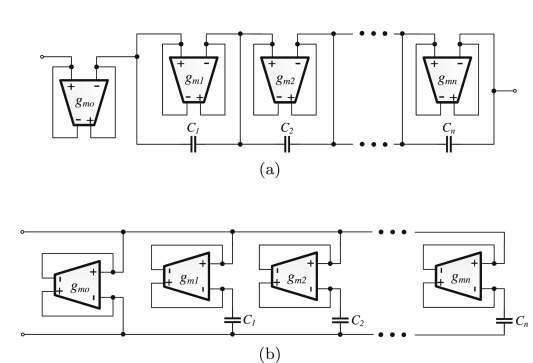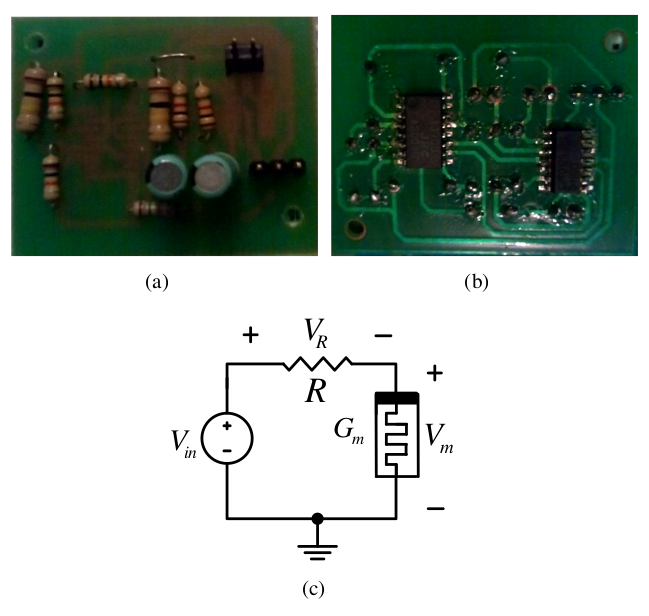Breadcrumb
Experimental verification of triple lobes generation in fractional memristive circuits
Recently, the triple-lobe behavior is found in the I-V characteristics of some memristive devices generating another non-zero pinchoff point. In this paper, a flux-controlled memristive model is developed to generate the triple-lobe behavior (double pinchoff points) based on a fractional second-order model. The conditions for observing triple lobes are derived besides the coordinates of the pinchoff points. Different scenarios have been considered by changing the model parameters and fractional order. Furthermore, the minimum and maximum achievable conductances are analyzed and mathematically

Realizations of simple fractional-order capacitor emulators with electronically-tunable capacitance
A novel resistorless topology for implementing fractional-order capacitor emulators, based on the employment of Operational Transconductance Amplifiers (OTAs) as active elements, is presented in this paper. The benefits of this topology are its simplicity in terms of component count, compared to other existing topologies in the literature, in addition to its electronic tunability. The performance of the presented topology is evaluated using Cadence and the 0.35 μm CMOS process Design Kit from Austria Mikro Systeme. Experimental results using commercial OTA chips are also provided, where the
Approximation of the fractional-order laplacian Sα as a weighted sum of first-order high-pass filters
A new approximation method of the fractional-order Laplacian operator sα is introduced. The approximation is based on a weighted sum of first-order filter sections and its analytical proof is given. The optimal high-pass filter section parameters that cover six frequency decades are obtained using the flower pollination algorithm while the effect of the number of filter sections on the accuracy of the approximation is investigated. Approximations of fractional-order capacitors of orders α =0.5 and α =0.7 synthesized in Foster-II form are given as a validating example. Further, an active
Fractional-order multi-phase oscillators design and analysis suitable for higher-order PSK applications
Recently, multi-phase oscillator design witnesses a lot of progress in communication especially phase shift keying based systems. Yet, there is a lack in design multi-phase oscillator with different fractional phase shifts. Thus, in this paper, a new technique to design and analyze a multi-phase oscillator is proposed. The proposed procedure is built based on the fractional-order elements or constant phase elements in order to generate equal or different phase shifts. The general characteristics equation for any oscillator is studied to derive expressions for the oscillation conditions and
Fractional order two port network oscillator with equal order
Most of electric circuits can be viewed as a two port network with two terminals defined as input and output ports. In this paper, two different concepts are combined together which are the two port network concept and the fractional calculus to design a general fractional order two port network with equal order. An oscillator case study with three impedances structure has been presented. The three impedances are two equal order fractional capacitors and a resistor. Two different two port network are studied which are Op-amp based circuit and nonideal gyrator circuit. The general oscillation
Fractional-order RC and RL circuits
This paper is a step forward to generalize the fundamentals of the conventional RC and RL circuits in fractional-order sense. The effect of fractional orders is the key factor for extra freedom, more flexibility, and novelty. The conditions for RC and RL circuits to act as pure imaginary impedances are derived, which are unrealizable in the conventional case. In addition, the sensitivity analyses of the magnitude and phase response with respect to all parameters showing the locations of these critical values are discussed. A qualitative revision for the fractional RC and RL circuits in the
Fractional-order impedance transformation based on three port mutators
Due to the importance of the mutators for active circuit realizations, this paper investigates different three port mutator circuits that can be used to implement a floating impedance. The analytical equations that govern the proposed circuits as well as the necessary conditions under different configurations are introduced to realize positive and negative impedances. The proposed circuits are based on second generation current conveyors (CCII) and/or transconductance Amplifier (TA). Moreover, the fractional-order impedance transformation using these mutators are investigated showing the

Simple floating voltage-controlled memductor emulator for analog applications
The topic of memristive circuits is a novel topic in circuit theory that has become of great importance due to its unique behavior which is useful in different applications. But since there is a lack of memristor samples, a memristor emulator is used instead of a solid state memristor. In this paper, a new simple floating voltage-controlled memductor emulator is introduced which is implemented using commercial off the shelf (COTS) realization. The mathematical modeling of the proposed circuit is derived to match the theoretical model. The proposed circuit is tested experimentally using
Rectangular waveguides in the fractional-order domain
This work introduces Maxwell's equations in their time domain fractional derivatives form. Some special cases of fractional order wave equations are shown. Studying the effect of fractional-order derivatives with respect to time on the generalized analysis and fundamentals of the rectangular waveguide is the main focus of this work. The effect of the fractional-order parameters on the waveguide properties is shown. Some of these properties are cutoff frequency and attenuation that are no longer fixed but controllable by the fractional parameters. Also, the intrinsic impedance is shown to be

Modulating the energy storage of supercapacitors by mixing close-to-ideal and far-from-ideal capacitive carbon nanofibers
The quest for high performance supercapacitors from the energy-power point of view is commonly addressed from the constituting electrode materials and/or the electrolyte. Carbon-based double-layer capacitors are known for their high power density, whereas pseudocapacitors which use transition metal oxides/nitrides/sulfides or conductive polymers are known for their high energy density. In this work we show that one can modulate the energy storage capability of supercapacitors by mixing at preset ratios two types of carbon materials having two different energy storage capabilities. The time
Pagination
- Previous page ‹‹
- Page 31
- Next page ››
